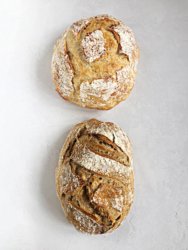Ingredients
3 cups (450 g) all-purpose flour* (can replace 1/3 with whole wheat)
1/4 teaspoon (1.25 mL) instant yeast
1 1/2 teaspoons (7 mL) salt
1 1/2 cups (350 mL) water
1/4 cup (60 mL) (or more) sourdough starter** (you don’t need to feed it first)
Instructions
In a large mixing bowl, combine the flour, yeast and salt.
Place the water in a 2-cup measuring cup. Add the starter and stir until the water looks milky. (Note: The starter doesn’t need to float to the top like with classic sourdough. Remember, I’m impatient.)
Pour the water over the flour and stir until blended, about 1 minute. The dough will be rough and shaggy, and fairly sticky.
Cover the bowl with plastic wrap, a silicone lid, or inverted plate. Leave at room temperature for 12 to 24 hours. (The warmer your kitchen, the quicker the rise. It’s early spring and cool here. I waited about 18 hours). The dough is ready when it has doubled and is full of air bubbles.
Dust your work surface with flour. Using wet hands, pull the dough out of the bowl and onto the work surface. If dough is sticking, add more flour as needed.
Flour your hands. Take one edge of dough and gently stretch it up and outward, then fold into the centre. Repeat with remaining 3 corners. Cover and let rest 15 minutes. Repeat the stretch-and-fold procedure. You will now have a ball.
Place the dough in a floured proofing bowl (banneton) or in a bowl with a tea towel generously coated in flour. Place SEAM SIDE UP. Cover and let rest 1 to 2 hours.
While the dough rests, place two-stacked baking sheets, a pizza stone, or a baking steel on the middle rack as insulation.*** Place a 6-8 litre cast-iron Dutch oven on top of your insulation barrier of choice and put the lid on. Preheat the oven to 450˚F (230°C). The extended heating time will help the bread bake.
The dough is ready when it springs back half way when given a light poke. Invert the dough onto a piece of parchment large enough to hold dough.
Slash the dough with a sharp knife or a lame (metal blade). A long slash will produce a longer loaf, a square slash will keep it round.
Lift the parchment by the edges and place it and the bread into the hot Dutch oven. Cover and bake 30 minutes. Remove the lid and continue baking 15 to 25 minutes, or until it reaches the desired darkness. If you’re not sure your bread is done, insert a thermometer into the centre of the bread from the side. It should read between 190°F and 210°F (88°C and 99°C). The more dense the bread, the higher the loaf’s internal temperature should be.
When done, lift the bread from the Dutch oven using the parchment as handles. Cool bread on a rack for at least an hour before slicing. The loaf will continue to cook during this time. It is normal to hear a crackle. If you tap on the bottom of the loaf it will sound hollow.
Notes
* You can use bleached or unbleached all-purpose flour, or bread flour.
** You don’t need to feed the starter. You can use the discarded starter or just grab some from your refrigerated stash. Don’t worry about accuracy. If you add more starter than needed, it works just fine. I’ve added up to 1/2 cup (125 ml). The starter can be cold or room temperature. Don’t fuss. Just try it.
***Not everyone has problem with their loaves burning on the bottom. If it’s not an issue for you, skip this step.
Keywords: no-knead, sourdough
